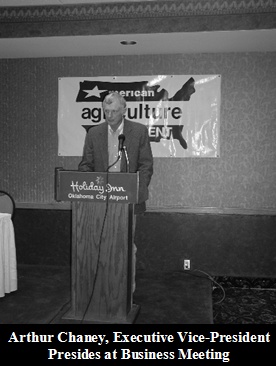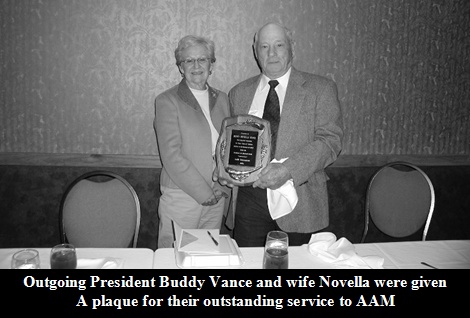
AAM Convention
By Ed Fashing
AAM held it’s 27th annual Convention January 5-8, 2006 in Oklahoma City.
Issues discussed were: biomass as an alternative energy source, a fair Parity
price for farm commodities, adoption of Country of Origin Labeling (COOL),
factory farms, uncontrolled market power of meat packers, free trade agreements,
loss of land rights, and multinational corporations’ control of agriculture.
Convention goers enjoyed presentations by newly-elected AAM President, Larry
Matlack, University of Tennessee Agricultural Economist Dr. Daryll Ray, Paragon
Foundation Magazine Editor E. B. Oliver III, DC consultant David Senter,
American Corn Growers Association CEO Larry Mitchell, and Lifetime Missouri AAM
member Wayne Cryts.

Larry Matlack explained that biomass now supplies 1-3% of U.S. energy and
potentially can supply 10-30%. Alternative energy sources are touted as
potentially supplying $1 billion in energy value while biomass alone could
potentially supply $10 billion.
Dr. Daryll Ray said there is an increased possibility of a recession if CRP is
eliminated. CRP should be increased to 45 million acres from 40 million acres.
Ray believes, “If for 2 years U.S. food production drops by 30% that the food
situation will be serious.”
Dr. Ray said, during his power-point presentation, “Technology is expanding
output faster than population and exports, therefore producing a drop in farm
prices.” “Foreign (AG) production has increased since the 1975 Farm Bill.” Dr
Ray told about new farming acreage that has come into the international market
from Russia, Ukraine, Poland, Brazil, and China. Brazil alone has more acreage
for crops that the U.S.

G.B. Oliver III told how most farmers and ranchers involved with land rights
problems with the federal government should have their cases tried in the Court
of Claims to receive payment for the highest and best use of their property
(unless their property is under $10,000 in value). The Paragon Foundation
defends ranchers’ and farmers’ land rights nationally.
Several speakers explained the need for biomass being used for energy production
and increased circulation of money (multiplier effect) in America. Today in many
rural areas, the multiplier is 2.2, while in the 1970’s it was 7 to 10. Some
experts believe 30% of all energy types can be supplied by biomass. Biomass can
come from cornstalks, soybean stove, wood chips, sawdust, or grasses.
Convention goers enjoyed good speakers, good food and good friends and vowed to
return home committed to increasing agriculture’s role in energy production in
order to rapidly improve farm income.
